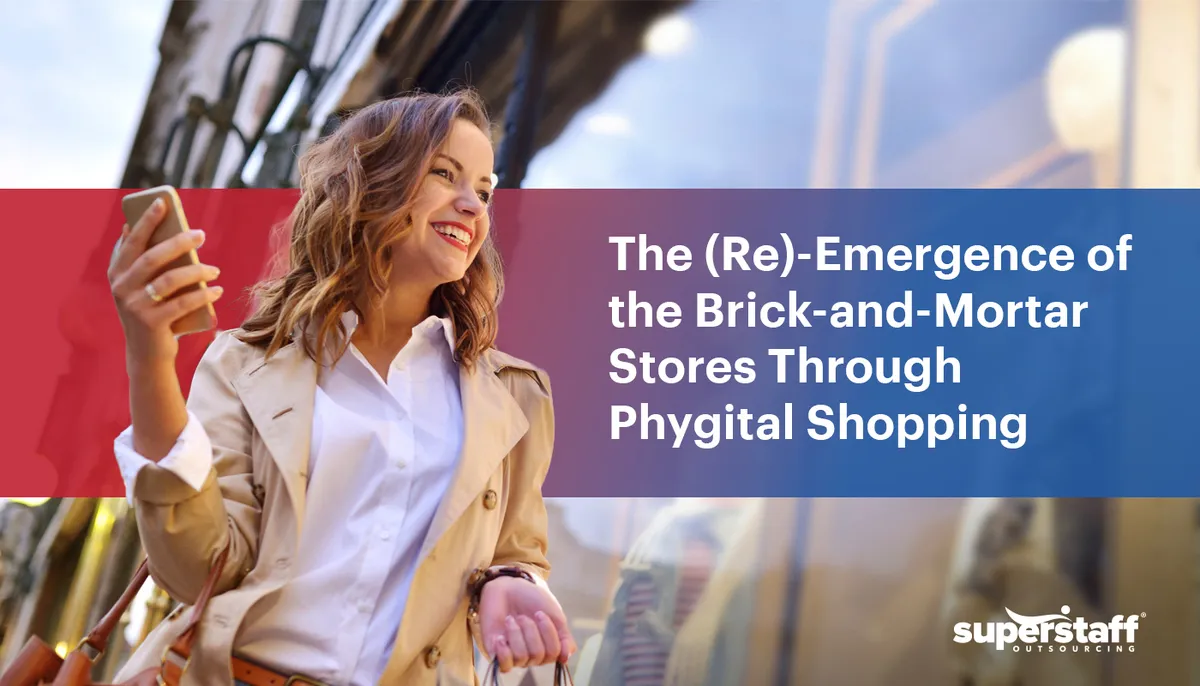
The past decade has been a wild ride for retail. Not too long ago, brick-and-mortar stores ruled the arena, and then e-commerce rose in the digital era, shaking things up faster than you can say “Add to Cart.”
Consumer habits reached 180° in record time, with tech advancements only fueling the fire. When the pandemic hit, brick-and-mortars were forced to shut down temporarily, and e-commerce suddenly became everyone’s best friend.
Lockdowns and social distancing got folks itching for in-person retail therapy. And while e-commerce threw some serious shade at physical stores, brick-and-mortar didn’t go down without a fight.
Three years later, brick and mortar is making a comeback — but this time, it has evolved and is poised to bring more “phygital” (physical+digital) experiences. Retailers combine the best of both worlds to give us shopping experiences we never knew we needed, and consumers are ready to hit the malls again.
What Is Phygital Retail?
Phygital retail combines the physical experience of shopping with the digital world. It’s like bringing the cool stuff you can do online into the store. Check out these phygital examples.
- Fun Displays: Ever seen screens in stores where you can browse stuff, read reviews, and even buy things? That’s the digital side making shopping easier.
- QR Code: Certain brands incorporate QR codes into their packaging. Customers can scan it, dive into their product info, play games, or even score some sweet prizes. It’s a great way to leverage the digital experience to engage with customers. Retailers can also create these codes using tools like the QR code generator by Uniqode, enabling quick production of dynamic QR codes that link to digital catalogs, feedback forms, event registrations, or loyalty programs. Beyond packaging, these codes can be placed on in-store displays, receipts, or promotional materials, allowing shoppers to instantly access offers, leave reviews, or join brand communities — all without manual data entry.
- Virtual Reality (VR) and Augmented Reality (AR): Ever tried on virtual clothes or seen how furniture would look in your place before buying? That’s VR and AR, making shopping fun and interactive.
- Phone Payments: Paying with your phone in-store instead of cash or cards. Quick and easy!
- Social Media Fun: Some stores bring social media into the mix by showing off what people say online about their products.
How Brick and Mortars Can Shift to Phygital Shopping
Brick-and-mortar stores are slowly but surely reclaiming their turf in retail. Savvy storefront businesses are rolling with the punches, adapting to changing consumer trends and tech innovations. They’re also getting more creative, exploring new avenues like omnichannel and experiential retail to keep things fresh.
Let’s dive into a few out-of-the-box phygital retail strategies you can leverage to breathe fresh life into the good ol’ shopping experience.
Omnichannel Retailing
Let’s talk shop — but not just any shop. We’re talking about omnichannel retailing.
In simple terms, omnichannel retailing is how stores connect with customers online and in person. For instance, a customer is browsing online for the perfect pair of shoes, then they decide to pop into the store to try them on. With omnichannel, you can offer personalized shopping experiences that flow seamlessly between the physical and digital worlds.
It’s meeting customers wherever they are, whether online, in-store, or somewhere in between. An omnichannel approach ensures a smooth personalized experience, keeping things consistent and on-brand no matter how they shop.
Besides the seamless transition from digital to physical, brands are taking it up a notch by turning their brick-and-mortar spots into media hubs. This full circle combines physical and digital experiences for a much greater reach. This can entail leveraging augmented reality (AR) and virtual reality (VR) to elevate the in-store experience. For instance, a sports brand can use a VR headset to simulate ball games in the store.
While technology continues to drive these high consumer expectations, it’s also the solution. With the right tech, retailers can keep tabs on their operations in real time, from the factory floor to the checkout counter.
This is why increasingly more businesses are leveraging an omnichannel approach. It elevates the phygital experience, boosting brand loyalty and customer retention (89% for companies with omnichannel strategies vs. 33% for companies with weak omnichannel approaches) and revenue growth.
Experiential Retail
In a cutting-edge approach known as experiential retail, physical stores now focus on providing unique experiences that cannot be replicated online. This typically entails interactive displays, in-store events, product demonstrations, and personalized customer service, enhancing the overall shopping experience and giving consumers an unforgettable shopping adventure. Think cool spaces, engaging activities, and tech that amps the fun.
But it’s not just about visual displays — it’s also about how the store feels. From slick design to spotless floors and the perfect lighting, it’s all about creating an environment as welcoming as it is on-brand.
Here are a few examples of phygital experiential retail:
- Nike’s House of Innovation: Nike’s flagship store in New York City is a prime example of experiential retail. It features interactive displays, customization stations where customers can personalize their shoes and even a basketball court where shoppers can test out sneakers before purchasing.
- Apple Stores: Apple is known for its sleek and modern stores that offer more than just products. Customers can attend workshops and events, get hands-on help with their devices at the Genius Bar, and experience the latest Apple technology.
- Lush Cosmetics: Lush stores are designed to engage the senses with vibrant colors, enticing scents, and interactive displays. Customers can sample products, attend workshops on how to make their cosmetics, and even watch demonstrations of how products are made in-store.
- REI’s Outdoor Experiences: Outdoor retailer REI offers a range of experiential activities in its stores, such as rock climbing walls, gear testing areas, and classes on outdoor skills like camping and hiking. These experiences attract customers to the store and foster community among outdoor enthusiasts.
- Samsung 837: Samsung’s flagship store in New York City is more than just a retail space — it’s a digital playground. Visitors can test the latest Samsung gadgets, attend workshops and events, and even participate in virtual reality experiences.
These showcase how experiential retail goes beyond traditional shopping by offering unique and immersive experiences that engage customers on multiple levels.
7 Ways to Boost Your Brick-and-Mortar’s Phygital Experience With Outsourcing Solutions
Ready to take your brick-and-mortar store to the next level? Well, buckle up because we’ve got five game-changing outsourcing solutions that’ll transform your shopping experience into something straight out of the future.
Logistics Support and Dispatch Services
One of the biggest reasons consumers prefer physical shopping is that it minimizes the time to get products, especially essentials such as groceries and toiletries. When you’re running low on essentials like milk or toothpaste, waiting for an online order doesn’t cut it. That’s why a physical store is the go-to for many folks — they need that stuff now, not later.
This means brick and mortars need to keep those shelves stocked. Every day, customers come in, expecting to find their favorite products on the shelves. Unfortunately, keeping track of inventory, managing orders, and ensuring everything gets delivered on time can be a logistical nightmare.
That’s where logistics support and dispatch services come in. These services help streamline the entire process, from ordering stock to getting it onto the shelves. They handle the nitty-gritty details like scheduling deliveries, optimizing routes, and managing inventory levels.
With the right logistics support, you can rest easy knowing that your store will always have the products your customers need right when they need them. And when your customers know they can rely on you for their essentials, they’ll return repeatedly.
Customer Service
Nowadays, customers are more plugged in than ever before. The 2021 Customer Experience Trends Report found that 65% of customers prefer to buy from companies that offer quick and hassle-free online transactions. Amazon scored the highest marks for service, largely due to its seamless online experience.
Exceptional customer service is critical to the success of brick-and-mortar stores — beyond just in-store interactions. It connects a customer’s online, mobile, and in-store experiences. Services like “Click and Collect” and “Click and Reserve” are great examples of retailers bridging this gap. For example, a customer can purchase boots online and pick them up later at the store. They can even receive an SMS notification on their phone when their order is ready for pickup.
What’s the key to achieving this? The short answer is outsourcing. Entrusting customer service tasks like inquiries, complaints, and returns to dedicated CX experts ensures that your customers get your brand of service excellence in-store and online.
E-commerce Management
The shift towards online shopping is undeniable. Despite the challenges faced by the retail sector in recent years, Statista reported that global retail e-commerce sales hit a whopping US$ 5.8 trillion. And the trend is expected to continue, with a projected 39% growth and an estimated $8 trillion.
The best way for brick-and-mortar to capitalize on this growth trajectory is by integrating online and offline retail efforts into their business strategy for increased reach and sales. E-commerce adds another revenue stream to your existing stores, providing you with a contingency plan in case customers can’t buy from your shop.
However, shifting from a physical presence to a phygital strategy isn’t always a walk in the park, especially if you lack the in-house resources and expertise. That’s where outsourcing comes in. Contracting out e-commerce management tasks to specialized professionals empowers brick and mortars to navigate this transition smoothly, ensuring a seamless integration of online and offline customer experiences while focusing on their core operations.
Multilingual Support
Native language matters a lot. It’s not just about speaking the same language, it’s about connecting with customers on a deeper level. When businesses communicate in their customers’ native language, it builds trust and confidence. Studies showed that 44% of consumers feel more connected to brands that speak their language, which can ultimately influence their purchasing decisions.
Catering to a multilingual customer base is crucial in today’s diverse but interconnected world. It’s a game-changer that allows businesses to assist individuals who feel more comfortable communicating in other languages, elevating customers’ shopping experiences and setting your brand apart from the competition.
Failing to provide this can lead to a lot of missed opportunities. If your business only communicates in one language, you could exclude potential customers who prefer interacting in a different language. This, in turn, can hinder your acquisition and retention efforts, ultimately impacting your bottom line.
Fortunately, even if you don’t have multilingual service agents, you can still achieve this through outsourcing. Delegating support to multilingual CS teams helps retailers to bridge language barriers and communicate effectively with customers in their preferred language — strengthening relationships and opening up new opportunities for growth and expansion.
Tech/Help Desk Support
In this digital age, technical hiccups can happen out of the blue. Whether it’s a glitchy mobile app, website, or other digital channels, these issues can throw a wrench into customers’ shopping experience. This is why you need expert tech and help desk support. Outsourcing this crucial function can ensure that IT-related problems are resolved swiftly, minimizing downtime and keeping customers happy.
So, what exactly is tech support? Support teams are unsung heroes working tirelessly to troubleshoot issues and provide technical solutions that keep things running smoothly.
Tech support isn’t just for big tech companies, though. Everyone needs a tech support team, from software firms to electronics manufacturers, even home appliance brands. With issues popping up at any time, these teams are available through multiple channels like phone, live chat, email, and sometimes even social media, ensuring that help is always just a click or call away.
Billings and Collections
Keeping tabs on billings and collections is at the heart of any business — it keeps the cash flowing and the lights on. However, managing these tasks efficiently can be a real headache. That’s where outsourcing accounting and collections comes in handy. Outsourced accounting and bookkeeping can streamline financial processes, slash overhead costs, boost their bottom line, and revolutionize a company’s pay-to-procure process.
Nowadays, businesses are seeking comprehensive finance and accounting support from BPOs. With cutting-edge analytics, companies can gain invaluable insights into their spending across the entire supply chain, allowing them to tighten budgets and standardize procedures across the board.
This approach isn’t just about crunching numbers — it’s about identifying opportunities for cost savings through supplier consolidation and rooting out pesky duplicate payments. Automating the process helps companies enhance policy compliance, slash order errors, and empower employees worldwide to make purchases when needed. This entails enforcing business rules and limits that prevent costly mistakes while keeping the financial ship sailing smoothly.
Back Office Support
Back office support might not be the flashiest part of running a brick-and-mortar store, but the engine keeps everything humming along smoothly. It’s the backstage crew at a concert. You may not see them, but they’re making sure the show goes on without a hitch.
Nowadays, it’s pretty much impossible to picture running a retail business without the help of technology. With competition heating up, retailers gotta stay on their toes and keep up with the times. That means diving headfirst into all the latest and greatest software solutions to streamline their operations.
Take giants like Kroger, Walmart, and 7Eleven, for example. These retail giants aren’t just sitting around but leading the charge when embracing new technologies. Whether it’s cutting-edge inventory management systems or customer service tools, they’re always at the forefront of innovation.
Innovation is the name of the game when it comes to back-office systems. This means making those behind-the-scenes processes faster, more efficient, and even cheaper. But let’s face it — not every brick-and-mortar shop has the budget for costly high-tech solutions.
Outsourcing can help. Teaming up with experts specializing in back-office support helps smaller businesses tap into top-notch technology and expertise without breaking the bank. It’s like having your virtual back office team ready to tackle whatever comes their way. Outsourcing could be just the ticket for giving your brick-and-mortar a competitive edge, whether managing inventory or handling finances. So you can focus more on efforts needed to go phygital.
Go Cutting-Edge, Go Phygital: Embrace Outsourcing Today!
SuperStaff is a trusted partner dedicated to delivering exceptional service and results when considering outsourcing solutions for your brick-and-mortar business. With years of experience and a proven track record, SuperStaff offers comprehensive outsourcing solutions tailored to meet the unique needs of retailers.
From customer service and e-commerce management to multilingual support and technical assistance, SuperStaff’s team of skilled professionals is committed to providing top-notch service and driving tangible business outcomes. With SuperStaff as your outsourcing partner, you can rest assured knowing that your operations are in capable hands, allowing you to focus on core business activities and confidently achieve your retail goals.






